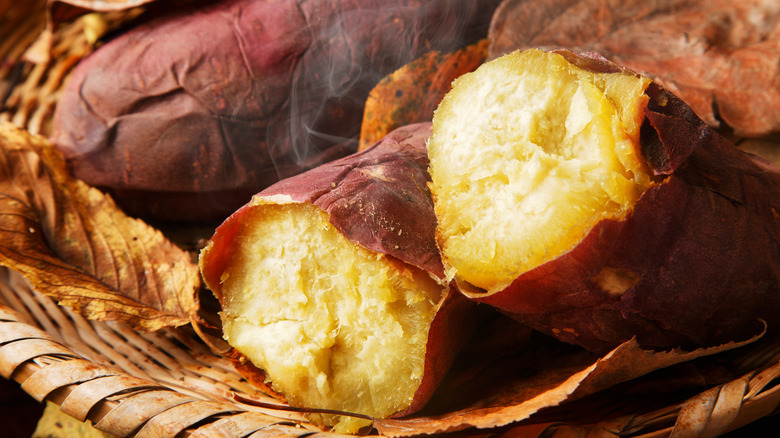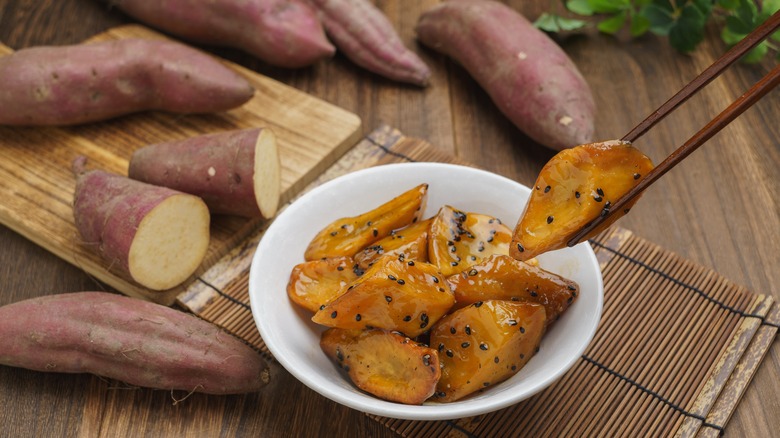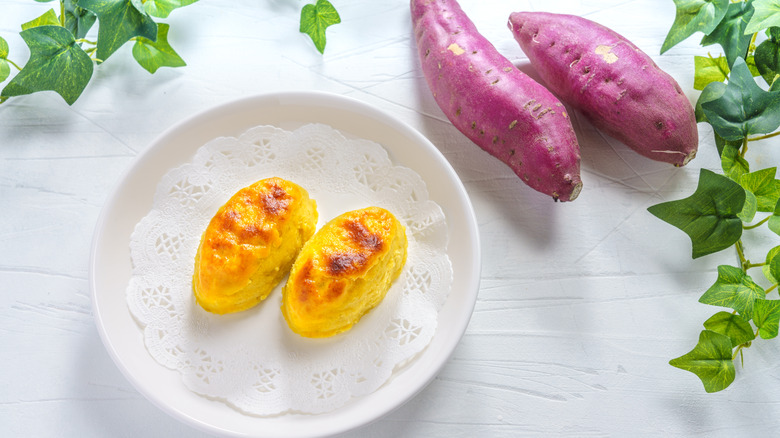Switch To Murasaki Sweet Potatoes For Crunchier And Creamier Results
Sweet potatoes can be mashed and seasoned, baked into a pie, or cut into wedges and roasted. If you're seeking a slightly different texture in your dishes, murasaki — often called Japanese sweet potatoes — might be a worthwhile substitution. You can distinguish these from other varieties by their outer appearance. While sweet potatoes with orange or brown skin are more commonly seen in stores, murasaki have a distinct purple-hued exterior. However, those differences aren't just skin-deep; the interior also deviates from the norm.
A major contrast is that the inner, white flesh of these sweet potatoes is firmer and crunchier than the orange varieties, making them perfect for creating crispy sweet potato fries. This firmness may be attributed to the potato's lower moisture content — murasaki have about 30 to 32% dry matter content.
Yet, this decreased moisture doesn't detract from the creaminess of these versatile vegetables. Once steamed or boiled, the inner flesh becomes dense and smooth, akin to the consistency of soft cheese. This is because murasaki are full of starch, which absorbs liquid and thickens up.
Murasaki can work in sweet or savory dishes
Murasaki sweet potatoes taste slightly earthier and less sweet than other varieties, yet they possess undertones of brown sugar, vanilla, chestnuts, and butter. These flavors, combined with the creamy texture when cooked, may complement a variety of desserts or mashes.
To balance the subtly rustic flavors, consider adding a bit more sugar to your standard sweet potato pie filling — or, increase the maple syrup for a maple-bourbon sweet potato pie. For a mash, enhance the inherent vanilla notes with brown sugar and cinnamon, or accentuate the savoriness with sage and butter.
If you prefer more full-bodied dishes, the earthiness of murasaki sweet potatoes may allow them to serve as substitutes for russet potatoes. Once their flesh is softened, puree the potatoes to enrich hearty soups, like a silky cauliflower cheddar soup. Alternatively, use murasaki as a base for hearty baked potatoes, garnished with bacon bits, sour cream, or shredded cheese. Naturally, they can also be sliced, seasoned with your favorite french fry spices, and baked or fried to crispy perfection.
How to purchase murasaki in the U.S.
Fortunately, you don't need to go to Japan to find murasaki. Despite being known as Japanese sweet potatoes, these tubers were actually developed at The University of Louisiana, where the Sweet Potato Research Station was established in 1948. Professor Donald La Bonte cross-pollinated two sweet potato varieties to create the disease-resistant murasaki variety in 2001. The university patented it in 2007, and the seeds were first sold commercially in 2008.
But why are they called Japanese sweet potatoes if they didn't originate in Japan? The term "murasaki" means purple in Japanese, which likely refers to the potato's outer skin, and the name has persisted. Nutritionally, murasaki are quite similar to orange sweet potatoes, but contain higher amounts of vitamins A and C, along with additional potassium and less sodium.
Nowadays, murasaki are primarily grown in California, and are available at select grocery stores, such as Trader Joe's, or farmers' markets. When selecting the best sweet potatoes at the store, look for murasaki with smooth, flawless skin. Once you've got your sweet potatoes, feel free to use them in your preferred potato-centric recipes.



